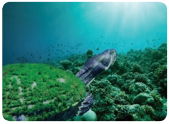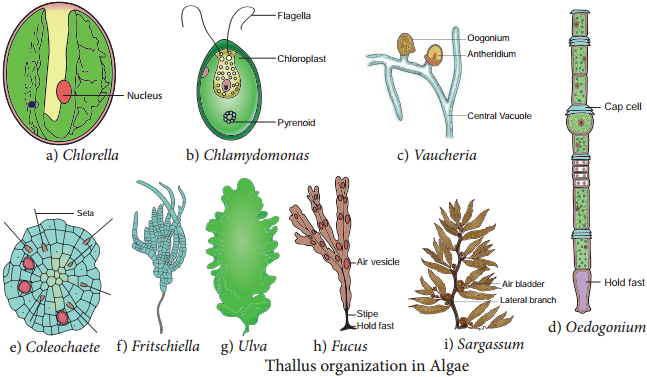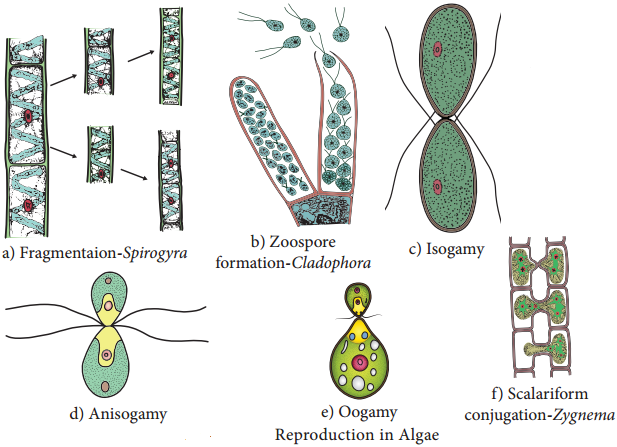Learninsta presents the core concepts of Biology with high-quality research papers and topical review articles.
Algae Classification and its Importance
Rain brings joy and life to various organisms on earth. Have you noticed some changes in and around you after the rain? Could you identify the reason for the slippery nature of the terrace and green patches on the wall of our home, green colour of puddles and ponds? Why should we clean our water tanks very often? The reason is algae.
Algae are simple plants that lack true roots, true stems and true leaves. Two-third of our earth’s surface is covered by oceans and seas. The photosynthetic plants called algae are present here. More than half of the total primary productivity of the world depends on this plant group. Further, other aquatic organisms also depend upon them for their existence.

Algae are autotrophs, and grow in a wide range of habitats. Majority of them are aquatic, marine (Gracilaria, and Sargassum) and freshwater (Oedogonium, and Ulothrix) and also found in soils (Fritschiella, and Vaucheria). Chlorella lead an endozoic life in hydra and sponges whereas Cladophora crispata grow on the shells of molluscs. Algae are adapted to thrive in harsh environment too.
Dunaliella salina grows in salt pans (Halophytic alga). Algae growing in snow are called Cryophytic algae. Chlamydomonas nivalis grow in snow covered mountains and impart red colour to the snow (Red snow). A few algae grow on the surface of aquatic plants and are called epiphytic algae (Coleochaete, and Rhodymenia). The study of algae is called algology or phycology. Some of the eminent algologists include F.E. Fritsch, F.E. Round, R.E. Lee, M.O. Parthasarathy Iyengar, M.S. Randhawa, Y. Bharadwaja, V.S. Sundaralingam and T.V. Desikachary.
General Characteristic Features
The algae show a great diversity in size, shape and structure. A wide range of thallus organisation is found in algae. Unicellular motile (Chlamydomonas), unicellular non-motile (Chlorella), Colonial motile (Volvox), Colonial non motile (Hydrodictyon), siphonous (Vaucheria), unbranched filamentous (Spirogyra), branched filamentous (Cladophora), discoid (Coleochaete) heterotrichous (Fritschiella), Foliaceous (Ulva) to giant kelps (Laminaria and Macrocystis). The thallus organization in algae is given in Figure 2.3.

Algae are eukaryotes except blue green algae. The plant body does not show differentiation into tissue systems. The cell wall of algae is made up of cellulose and hemicellulose. Siliceous walls are present in diatoms. In Chara the thallus is encrusted with calcium carbonate.
Some algae possess algin, polysulphate esters of polysaccharides which are the sources for the alginate, agar agar and carrageenan. The cell has a membrane bound nucleus and cell organelles like chloroplast, mitochondria, endoplasmic reticulum, golgi bodies etc., Pyrenoids are present. They are proteinaceous bodies found in chromatophores and assist in the synthesis and storage of starch.
The pigmentation, reserve food material and flagellation differ among the algal groups. Algae reproduces by vegetative, asexual and sexual methods (Figure 2.4).
Vegetative reproduction includes fission (In unicellular forms the cell divides mitotically to produce two daughter cells Example: Chlamydomonas); Fragmentation (fragments of parent thallus grow into new individual Example: Ulothrix) budding (A lateral bud is formed in some members like Protosiphon and helps in reproduction) bulbils, (a wedge shaped modified branch develop in Sphacelaria) akinetes (Thick walled spores meant for perennation and germinates with the advent of favourable condition Example: Pithophora) and Tubers (Structures found on the rhizoids and the lower nodes of Chara which store food materials).

Asexual reproduction takes place by the production of zoospores motile spores (Ulothrix, Oedogonium) aplanospore (thin walled non motile spores Example: Vaucheria); autospores (spores which look similar to parent cell Example: Chlorella); hypnospore (thick walled aplanospore – Example: Chlamydomonas nivalis) and Tetraspores (Diploid thallus of Polysiphonia produce haploid spores after meiosis).
Sexual Reproduction in Algae is of Three Types
- Isogamy (Fusion of morphologically and Physiologically similar gametes Example: Ulothrix)
- Anisogamy (Fusion of either morphologically or physiologically dissimilar gametes Example: Pandorina)
- Oogamy (Fusion of both morphologically and physiologically dissimilar gametes. Example: Sargassum).
The life cycle shows distinct alternation of generation.
Classification
F.E. Fritsch proposed a classification for algae based on pigmentation, types of flagella, reserve food materials, thallus structure and reproduction. He published his classification in the book “The structure and reproduction of the Algae”(1935). He classified algae into 11 classes namely Chlorophyceae, Xanthophyceae, Chrysophyceae, Bacillariophyceae, Cryptophyceae, Dinophyceae, Chloromonadineae, Euglenophyceae, Phaeophyceae, Rhodophyceae, Cyanophyceae. The salient features of Chlorophyceae, Phaeophyceae and Rhodophyceae are given below.
Chlorophyceae
The members are commonly called ‘Green algae’. Most of the species are aquatic (Fresh water-Spirogyra, Marine – Ulva). A few are terrestrial (Trentipohlia). Variation among the shape of the chloroplast is found in members of algae. It is cup shaped (Chlamydomonas), discoid (Chara), girdle shaped, (Ulothrix), reticulate (Oedogonium), spiral (Spirogyra), stellate (Zygnema) and plate like (Mougeoutia).
Chlorophyll ‘a’ and Chlorophyll ‘b’ are the major photosynthetic pigments. Storage bodies called pyrenoids are present in the chloroplast and store starch. They also contain proteins. The cell wall is made up of inner layer of cellulose and outer layer of pectin.
Vegetative reproduction takes place by means of fragmentation and asexual reproduction is by the production of zoospores, aplanospores and akinetes. Sexual reproduction is present and may be isogamous, anisogamous or oogamous. Examples for this group of algae includes Chlorella, Chlamydomonas, Volvox, Spirogyra, Ulothrix, Chara and Ulva.
Phaeophyceae
The members of this class are called ‘Brown algae’. Majority of the forms are found in marine habitats. Pleurocladia is a fresh water form. The thallus is filamentous (Ectocarpus) frond like (Dictyota) or may be giant kelps (Laminaria and Macrocystis). The thallus is differentiated into leaf like photosynthetic part called fronds, a stalk like structure called stipe and a holdfast which attach thallus to the substratum.
The Pigments include Chlorophyll a, c, Carotenoids and Xanthophylls. A golden brown pigment called fucoxanthin is present and it gives shades of colour from olive green to brown to the algal members of this group. Mannitol and Laminarin are the reserve food materials.
Motile reproductive structures are present. Two laterally inserted unequal flagella are present. Among these one is whiplash and another is tinsel. Although sexual reproduction ranges from isogamy to oogamy, Most of the forms show oogamous type. Alternation of generation is present (isomorphic, heteromorphic or diplontic). Examples for this group include Sargassum, Laminaria, Fucus and Dictyota.
Rhodophyceae
Members of this group include ‘Red algae’ and are mostly marine. The thallus is multicellular, macroscopic and diverse in form. Porphyridium is the unicellular form. Filamentous (Goniotrichum) ribbon like (Porphyra) are also present.
Corallina and Lithothamnion are heavily impregnated with lime and form coral reefs. Apart from chlorophyll a, r-phycoerythrin and r-phycocyanin are the photosynthetic pigments. Asexual reproduction takes place by means of monospores, neutral spores and tetraspores.
The storage product is floridean starch. Sexual reproduction is oogamous. Male sex organ is spermatangium which produces spermatium. Female sex organ is called carpogonium. The spermatium is carried by the water currents and fuse with egg nucleus to form zygote.
The zygote develops into carpospores. Meiosis occurs during carpospore formation. Alternation of generation is present. Examples for this group of algae include Ceramium, Polysiphonia, Gelidium, Cryptonemia and Gigartina.
Economic Importance
The Economic importance of Algae is given in Table 2.2
